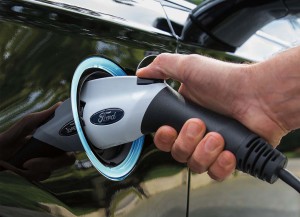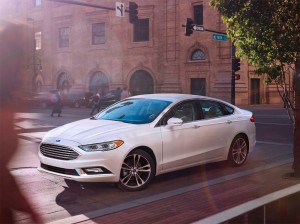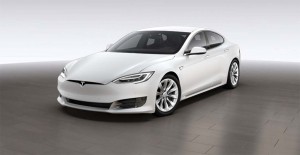Facing strict new emissions rules that favor a shift to battery power Ford Motor Co. plans to roll out an assortment of new electrified vehicles for the Chinese market.
Ford will have electrified versions of most of its offering in China by 2025, CEO Mark Fields announced, two weeks ahead of the Shanghai Motor Show. And it plans to start building them locally, as well.
“The time is right for Ford to expand our EV lineup and investments in China,” Ford’s Fields said in a statement, adding that the second-largest U.S. automaker is “prioritizing our electrification efforts on China to reflect its importance.”
(New study finds Ford leading in race for autonomous vehicles. Click Here for more.)
The Chinese government for years focused on encouraging production and sales of conventional, gas-powered vehicles as a way to kick start the country’s economy – much as the auto industry served as an engine for building the American middle class in the first half of the 20th Century. But, with growing concerns about the endemic smog problems facing cities like Shanghai and Beijing, the government has shifted focus to alternative power, primarily electric.
Some key cities, including Shanghai and Beijing, have enacted monthly registration limits meant to hold down both emissions problems and growing traffic congestion. Buyers of certain electrified vehicles are exempt from the restrictions, however.
The central government also has taken steps to subsidize the manufacturing of electrified vehicles, automakers expected to pass such savings onto consumers.
While sales of electric vehicles hasn’t grown as fast as the central government would like – mirroring the shortfall experienced under the Obama Administration – China is nonetheless the world’s largest market for battery-based vehicles, surpassing the U.S. in 2015. An estimated 500,000 hybrids, plug-ins and pure battery-electric, or BEV, models were sold there last year.
(Why is Ford spending $1bil for Argo AI? Click Here to find out.)
Several domestic brands, notably including Xi’an-based BYD, focus primarily on electric vehicles, and are hoping the government’s shift in focus will help transform them into leaders in the Chinese industry. The vast majority of battery-based products sold in China last year came from homegrown manufacturers.
Foreign brands were reluctant, at first, in part worried about sharing proprietary technologies with China firms. The government there requires all non-Chinese automakers to partner with local manufacturers. But that is beginning to shift. Daimler AG, Volkswagen and other European makers, as well as several U.S. brands, are starting to enter the Chinese battery-car market.
That includes Tesla, the Silicon Valley EV manufacturer which revealed in a March 1 filing it sold $1 billion worth of vehicles in China. It has not said how many vehicles that included, though the Wall Street Journal estimated the figure at around 11,000. Significantly, China’s Tencent Holdings recently disclosed it had acquired a 5% stake in Tesla.
(Tesla poised to overtake GM as most valuable US car company. Click Here for the latest.)
How big the market for battery power will grow in China is uncertain, though consulting firm Gao Feng Advisory predicts 32 million so-called new energy vehicles will be in operation there by 2025.
Ford was a relative latecomer among foreign brands entering China and has been aggressive in its bid to catch up to rivals like General Motors and VW, the two market leaders.
In the U.S., Ford has launched an aggressive electrification program and already sells a mix of hybrids, plug-ins and pure EVs. Sales of its BEVs have been slower than expected, analysts suggesting range and price are problems. The maker is expected to mirror GM’s strategy with the Chevrolet Bolt EV and bring out a model with at least 200 miles range in the near future.
In China, the carmaker says it plans to have its first plug-in hybrid, the Ford Mondeo Energi on sale in 2018. It will follow with a fully electric SUV within five years, and have 70% of its models available with some form of battery-based driveline by 2025. Local manufacturing of electrified powertrains, meanwhile, will get underway by 2020, according to Ford.
Globally, the company said, it will spend $4.5 billion on electrification efforts. That is expected to include the development of 13 global EVs set to hit the road within the next five years.



